Which way is up?
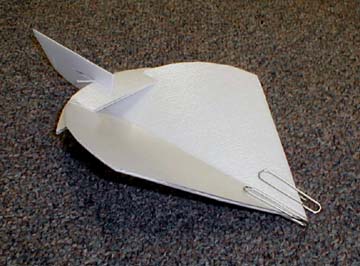
Which way is up?

Introduction
A disk of Styrofoam is used to investigate the design of stable airplanes.
Material
Assembly
Cut a flat circular disk out of the polystyrene foam plate.
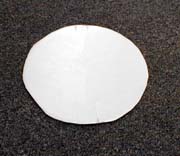
Which way is forward?
To Do and Notice
Try to fly the circular disk.
Notice it will not fly, it flutters.
Notice that you can balance the disk on a finger at its
center.
The center of mass of the plate is at its center.
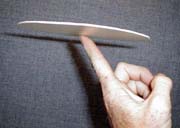
Hold the disk in the upward flow of air from a large fan.
Use one finger or two to balance the disk against the force from the
fan.
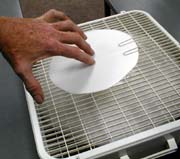

Notice that the finger is near the center of the disk.
The finger is at the center of (air) pressure on the disk.
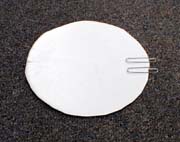
Add 2 large paper clips side by side to one point on the rim of
the disk.
Notice that the disk balances at a point between the center and the
paper clips.

The paper clips mark the "front" of the airplane.
Gently toss the airplane with the paper clips in front.
Notice that it flies better than before.
Notice that the disk plane "rocks and rolls" as it glides to the
ground.
Gently toss the plane backward that is with the paper clips toward
the back.
Notice that the plane tumbles. The disk now has a definite front.
Doing better
You want to make the plane fly on a gentle slope to the ground.
If the nose drops and it dives into the ground then the nose is
too heavy.
Remove some weight. Or push the paper clips back toward the center of
the disk.

If the nose rises up and then drops again and again, the nose is
too light.
Add more weight. Or pull the paper clips away from the center.
What’s Going On?
The plane has a center of mass, also known as its center of
gravity.
The plane will balance on a finger placed under this point.
It is as if all of the gravity forces on the atoms which make up the
disk act as one gravity force, FG, through the center of
mass.
Even more important, an object tossed into the air will rotate about
its center of mass.
The plane also has a center of pressure.
The disk behaves as if all the forces of air act as one force,
FA, at the center of pressure.
The center of pressure of the disk is at the center of the disk.
(The center of pressure is also the center of mass of a shape cut to
match the shadow of the plane.)

As the plane falls under gravity air pushes up on the wing acting
like a single force at the center of pressure, the center of our
disk.
Gravity pulls down at the center of gravity.
If the center of gravity and center of pressure are close together
the disk tumbles through the air.
However if the center of gravity is moved toward one edge of the
disk by adding weights.
There will be a twisting force, or torque, on the disk.
Gravity will pull down the nose while air pressure pushes up the
center.
The plane will rotate.
The nose will drop, and the plane will slide through the air toward
the ground nose first.
If the center of gravity (aka the center of mass) is too far forward of the center of pressure the plane will dive nose first into the ground. Cure this b removing weight from the nose or sliding the weight toward the tail.
If the center of gravity is to close to the center of pressure the nose of the plane will rise up and it will stall. Add more weight t the nose, or move the weight forward.
Which way is Up ?
Now that your plane has a front, toss it upside down, or tilted at
an angle.
It rocks side to side and is not very stable.
You can give it a top and a bottom by bending the wings up, that
is, giving them dihedral.
Draw a ball point pen line on the top of the plate, through the
center from the nose to the tail.
Draw the line several times until you make an obvious groove down the
center of the plane.
Bend the wings of plane up along this line.
(Optional, you can run a strip of tape across the center of the top
of the wing to help hold the wings in an upward V)
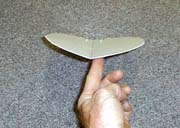
Fly the plane.
Notice that it is stable.
Tip it to the side and it rights itself.
Fly it up-side-down and it rolls over right-side up.
What's Going on?
If the plane is tipped to the right the right wing will be more parallel to the ground and the left wing more at an angle. There will be a greater upward force on the right wing which will push the plane back to a level attitude.
It is absolutely essential to draw the line down the center of the lane with the ball point pen before you bend the Styrofoam. The ball point compresses the Styrofoam and allows it to bend instead of breaking.
Which way is right ?
The plane can be made even more stable by giving it a tail, a vertical stabilizer, and swept back wings.
Draw straight lines from the nose of the airplane to the center of each edge. Cut the foam along these lines.
The disk will now have swept back wings.
Cut a slot in one of these pieces of foam and slide it onto the rear of the plane making a vertical stabilizer. The slot works better if it is made slightly wider by sanding it with an emery board, the kind usually used to file nails.
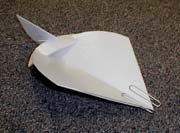
A Styrofoam plane using both trim pieces, one as a horizontal
stabilizer, one as a vertical stabilizer.
Be creative, I added one of the trimmed-off pieces as a horizontal stabilizer. This horizontal piece slid into cuts in each wing making a strong triangular brace to give the plane its shape.
Find the center of pressure of your plane b balancing it against the airflow from a fan.
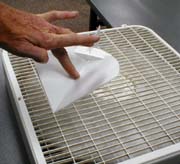
Finding the center f pressure of your plane.
Also find the center of gravity. Notice, the center of gravity will be in front of the center of pressure.
What's going On?
If the plane tries to point to the right the tail acts as a weather vane and turns it back to point in the direction of flight.
If the plane points to the right of the flight path, the left wing hits the air straighter than the right one, the force of the air on the left wing is greater, this pushes the left wing back turning the nose into the direction of flight
Use a pen to mark two rectangles near the rear of the plane 1 cm wide and 3 cm long. Cut along the short edges of these rectangles with scissors make a groove along the front edge with the ball point pen, and bend them upward to form elevons.
Rebalance your plane.
Add or subtract paper clips, or move them forward and backward.
Have fun flying your stable aircraft.
References
My favorite reference for Aerosynamics is the "Beginner's Guide to Aerodynamics" by Tom benson, published by NASA, Glenn Research Center
|
Scientific Explorations with Paul Doherty |
|
20 October 2000 |